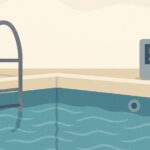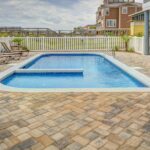Crystal Clear Water Doesn’t Mean Perfect Pool Chemistry: The Tennessee Pool Owner’s Guide to True Water Balance
Your pool water looks absolutely perfect. Crystal clear, sparkling blue, no algae in sight. You pat yourself on the back for adding chlorine faithfully and saving money by skipping all those “unnecessary” balancing chemicals. Meanwhile, your pool is quietly destroying itself from the inside out, and you won’t realize it until thousands of dollars in damage has already been done.
This is one of the most expensive misconceptions in pool ownership, and after years of helping Tennessee pool owners recover from this costly mistake, I’m here to explain why crystal clear water can actually be your pool’s worst enemy.
💎 Dangerous Clarity Truth: “Acid water is crystal clear precisely because it’s hostile to life – including algae, swimmers, and your expensive pool equipment.”
The Crystal Clear Water Deception
Why Bad Water Looks Perfect
Here’s what most pool owners don’t understand: severely unbalanced water often appears more clear than properly balanced water. Acidic water with low pH and alkalinity creates conditions so harsh that algae simply cannot survive. Additionally, the aggressive water dissolves microscopic particles and debris that would normally cause slight cloudiness in balanced water.
Signs your “perfect” clear water might be destroying your pool:
- Water is crystal clear but has a slight “bite” or sting to eyes
- Pool surfaces feel slightly rough or etched
- Metal fixtures show signs of corrosion or discoloration
- Swimmers experience skin irritation or dry hair
- Pool equipment seems to need repairs more frequently
- Chlorine seems to disappear quickly despite clear water
The Acid Water Problem in Tennessee
Tennessee’s climate creates perfect conditions for this deceptive problem. Our hot, humid summers cause rapid evaporation, concentrating acids in the water. Heavy summer storms add acidic rainwater that drives pH down further. Many Tennessee pool owners compound this by adding muriatic acid to lower pH but never adding alkalinity buffer to stabilize it.
What acid water actually does:
- Dissolves pool surfaces like a slow-acting solvent
- Corrodes metal equipment from the inside out
- Burns off stabilizer leaving chlorine defenseless against UV
- Etches and pits pool surfaces permanently
- Creates aggressive water that attacks everything it touches
⚖️ Balance Reality: “Your pool is either eating itself or growing algae. There’s very little middle ground in pool chemistry.”
Pool Chemistry: Your Four Pillars of Protection
Think of pool water balance like a four-legged chair. Remove any leg, and the whole system becomes unstable and dangerous. Each chemical plays a specific protective role that cannot be replaced by the others.
1. pH – The Master Controller (7.2-7.6)
What it controls: How acidic or basic your water is Why it matters: Controls how effectively all other chemicals work Tennessee challenge: Heat and evaporation constantly drive pH down
When pH is too low (under 7.0):
- Chlorine becomes hyperactive and burns off quickly
- Water becomes aggressive and starts dissolving surfaces
- Swimmers experience burning eyes and skin irritation
- Metal equipment corrodes rapidly
- Pool surfaces etch and pit permanently
When pH is too high (over 7.8):
- Chlorine becomes lazy and ineffective
- Scale formation begins on surfaces and equipment
- Water becomes cloudy despite adequate filtration
- Swimmers experience dull, lifeless water feel
2. Total Alkalinity – The pH Bodyguard (80-120 ppm)
What it does: Prevents rapid pH swings and stabilizes water chemistry Why it’s critical: Acts as a buffer against pH changes from weather, swimmers, and chemicals Tennessee importance: Our unpredictable weather requires extra pH stability
When alkalinity is too low (under 60 ppm):
- pH bounces wildly with any chemical addition
- Water becomes aggressive and corrosive
- Equipment suffers rapid deterioration
- Chemical additions become unpredictable and dangerous
- Pool surfaces experience severe etching
When alkalinity is too high (over 150 ppm):
- pH becomes locked in high position
- Scale formation accelerates
- Water becomes difficult to balance
- Chlorine effectiveness decreases significantly
3. Stabilizer/Cyanuric Acid – The Chlorine Protector (30-50 ppm)
What it does: Protects chlorine from being destroyed by UV rays Tennessee necessity: Our intense summer sun destroys unstabilized chlorine in hours Hidden danger: Too much stabilizer makes chlorine completely ineffective
When stabilizer is too low (under 20 ppm):
- Chlorine burns off rapidly in sunlight
- Chemical costs skyrocket during summer
- Algae growth becomes constant battle
- Pool becomes expensive to maintain
When stabilizer is too high (over 80 ppm):
- Chlorine becomes locked up and ineffective
- Algae growth despite high chlorine readings
- Water becomes impossible to shock effectively
- Only solution is partial water replacement
4. Calcium Hardness – The Equipment Guardian (150-300 ppm)
What it does: Prevents water from being corrosive or scale-forming Why it matters: Protects expensive equipment and pool surfaces Tennessee factor: Our water sources vary dramatically by region
When calcium is too low (under 100 ppm):
- Water becomes aggressive and hungry for minerals
- Steals calcium from pool surfaces and equipment
- Grout dissolves and tile becomes loose
- Metal components corrode rapidly
- Pool surfaces etch and become rough
When calcium is too high (over 400 ppm):
- Scale formation clogs equipment
- Water becomes cloudy and difficult to balance
- Filtration systems work overtime and fail prematurely
- Pool surfaces develop white, chalky deposits
🏗️ Equipment Investment Protection: “Your pool equipment represents thousands of dollars in investment. Balanced water is the cheapest insurance policy you’ll ever buy.”
Your Pool is Like a Garden: The Maintenance Mindset
The Plant-and-Ignore Mistake
Just as you can’t plant a garden and ignore it for months, you cannot achieve long-term pool success by adding only chlorine. Gardens need water, fertilizer, pest control, and regular attention. Similarly, pools need chlorine, pH control, alkalinity management, stabilizer protection, and calcium balance.
The chlorine-only approach is like:
- Watering your garden but never adding fertilizer
- Taking vitamins but never eating real food
- Changing your car’s oil but never checking other fluids
- Paying your mortgage but ignoring insurance, taxes, and maintenance
What actually happens with chlorine-only maintenance:
- Month 1-2: Pool looks great, owner feels smart for “saving money”
- Month 3-6: Subtle equipment problems begin, surfaces start showing wear
- Month 6-12: Major equipment failures, surface damage becomes obvious
- Year 2-3: Thousands in repairs, possible pool resurfacing needed
- Long-term: Complete equipment replacement, structural damage
The True Cost of “Cheap” Pool Care
Perceived savings from skipping balancing chemicals:
- Alkalinity increaser: “saved” moderate cost monthly
- pH buffer: “saved” moderate cost monthly
- Stabilizer: “saved” moderate cost seasonally
- Calcium hardness: “saved” moderate cost annually
- Total perceived annual savings: Moderate amount
Actual costs of unbalanced water:
- Equipment repairs: High costs annually
- Surface damage: Very high repair/replacement costs
- Increased chemical usage: Chlorine costs double or triple
- Professional service calls: High costs for emergency fixes
- Equipment replacement: Thousands for premature failures
- Pool resurfacing: Tens of thousands if surfaces are damaged
- Total actual annual costs: Potentially tens of thousands
💸 Financial Reality Check: “Skipping balancing chemicals to save money is like canceling your car insurance to save on monthly payments – it works great until disaster strikes.”
Surface Damage: How Unbalanced Water Destroys Different Pool Types
Fiberglass Pools: The Gel Coat Nightmare
What happens with unbalanced water: Fiberglass pools have a protective gel coat layer that gives them their smooth, non-porous surface. Unbalanced water attacks this gel coat systematically.
Low pH damage:
- Gel coat becomes etched and rough to the touch
- Surface loses its smooth, slippery feel
- Staining becomes permanent as etching creates microscopic pits
- Color fading accelerates as protective layer deteriorates
- Repair cost: Gel coat restoration ranges from expensive to very expensive
High pH damage:
- Scale buildup becomes bonded to the surface
- Calcium deposits become impossible to remove without damaging gel coat
- Surface becomes rough and attracts more scale formation
- Repair cost: Professional scale removal or gel coat refinishing required
High stabilizer damage:
- Algae becomes impossible to eliminate
- Black algae can actually penetrate damaged gel coat
- Surface must be aggressively brushed, causing more damage
- Long-term result: Complete gel coat failure requiring pool refinishing
Vinyl Liner Pools: The Premature Replacement Problem
What happens with unbalanced water: Vinyl liners are designed to last 8-12 years with proper water balance. Unbalanced water can destroy them in 2-3 years.
Low pH damage:
- Vinyl becomes brittle and prone to tearing
- Liner shrinks and pulls away from pool walls
- Seams fail prematurely due to vinyl degradation
- Color fading accelerates dramatically
- Replacement cost: Complete liner replacement every few years instead of decade+
High pH damage:
- Scale formation bonds to vinyl surface
- Scale cannot be removed without damaging liner
- Liner becomes rough and uncomfortable for swimmers
- Premature aging from constant chemical imbalance
Low calcium damage:
- Water steals plasticizers from vinyl
- Liner becomes hard and brittle
- Wrinkles and folds become permanent
- Result: Premature liner replacement at high cost
Gunite/Concrete Pools: The Structural Nightmare
What happens with unbalanced water: Concrete pools seem indestructible, but unbalanced water can cause structural damage costing tens of thousands to repair.
Low pH damage (acid washing effect):
- Concrete surface becomes etched and rough
- Aggregate (pebbles/stones) becomes exposed and sharp
- Plaster dissolves systematically, thinning the protective layer
- Rebar becomes exposed to water, causing rust and expansion
- Structural damage: Cracks develop from rebar expansion
- Repair cost: Complete pool replastering or resurfacing
High pH damage:
- Scale formation becomes bonded to plaster
- Surface becomes increasingly rough and difficult to clean
- Scale provides foothold for black algae growth
- Long-term result: Acid washing required, which thins plaster further
Low alkalinity damage:
- Plaster dissolves rapidly in unbuffered acidic water
- Surface becomes increasingly rough and pitted
- Catastrophic result: Plaster failure exposing concrete substrate
🏊♀️ Surface Truth: “Every pool surface type fails differently with unbalanced water, but they all fail expensively.”
Equipment Destruction: How Chemical Neglect Kills Your Investment
Pool Pumps: The Heart Under Attack
How unbalanced water destroys pumps:
Low pH effects:
- Impeller blades corrode and develop pits
- Volute housing develops pinhole leaks
- Seal faces corrode, causing rapid seal failure
- Motor shaft corrodes where it enters the wet end
- Failure mode: Catastrophic seal failure, motor burnout from water intrusion
High pH effects:
- Scale formation in volute reduces flow rates
- Impeller becomes unbalanced from scale buildup
- Increased friction causes motor to work harder and run hotter
- Failure mode: Motor overheating, bearing failure, complete pump replacement
Low calcium effects:
- Aggressive water attacks metal components
- Corrosion accelerates throughout pump assembly
- Result: Complete pump replacement years ahead of schedule
Pool Heaters: The Expensive Casualty
How unbalanced water destroys heaters: Pool heaters contain complex heat exchangers with tight tolerances. Unbalanced water turns them into expensive scrap metal.
Low pH effects:
- Heat exchanger tubes develop pinhole leaks
- Copper components corrode and fail
- Repair reality: Heat exchanger replacement often costs more than new heater
High pH effects:
- Scale formation clogs heat exchanger passages
- Reduced flow causes overheating and shutdown
- Scale acts as insulator, reducing heating efficiency
- Performance loss: Heater works harder, costs more to operate, fails sooner
High stabilizer effects:
- Copper heat exchangers suffer accelerated corrosion
- Chlorine becomes ineffective, allowing bacteria growth in warm heater
- Biological damage: Bacteria can actually eat metal components
Pool Filters: The Overworked Protectors
How unbalanced water overworks filtration systems:
Sand filters with unbalanced water:
- Low pH dissolves sand media prematurely
- High pH causes sand to cement together, reducing effectiveness
- Aggressive water corrodes internal components and valve systems
- Result: Frequent media replacement, valve rebuilds, complete system failure
Cartridge filters with unbalanced water:
- Low pH dissolves filter fabric
- High pH causes rapid scale formation, clogging cartridges
- Aggressive water attacks filter housing and fittings
- Cost impact: Cartridge replacement frequency doubles or triples
DE filters with unbalanced water:
- Aggressive water attacks filter grids
- Scale formation makes cleaning impossible
- Internal components corrode and fail
- Expensive reality: Grid replacement every season instead of every 5-7 years
⚙️ Equipment Economics: “Replacing a pump costs moderate money. Replacing a heater costs high money. Replacing plaster costs very high money. Maintaining water balance costs very little money.”
The Tennessee-Specific Balancing Challenge
Climate Factors Affecting Balance
Summer heat effects:
- Rapid evaporation concentrates all chemicals
- High temperatures accelerate chemical reactions
- Intense UV destroys stabilizer and chlorine rapidly
Humidity impacts:
- High humidity slows evaporation, concentrating chemicals differently
- Creates perfect conditions for scale formation
- Affects chemical storage and effectiveness
Storm effects:
- Acidic rainwater drives pH down rapidly
- Dilution affects all chemical levels unpredictably
- Organic debris adds phosphates and nitrates
Regional water differences:
- East Tennessee: Generally softer water, low calcium
- Middle Tennessee: Variable hardness, moderate alkalinity
- West Tennessee: Often harder water, higher pH
- Implication: One-size-fits-all approach doesn’t work
Seasonal Balance Adjustments
Spring startup:
- Test and adjust all four pillars before adding chlorine
- Address winter chemical drift systematically
- Don’t rush to clear water – balance first, then sanitize
Summer maintenance:
- Weekly testing of all parameters, not just chlorine and pH
- Proactive stabilizer management for UV protection
- Calcium hardness monitoring as water evaporates
Fall transition:
- Maintain balance even as usage decreases
- Protect equipment during temperature swings
- Prepare balanced water for winter or closure
Weekly Maintenance: Your Success Schedule
The Four-Pillar Weekly Routine
Every week, test and adjust:
- pH first – Controls everything else
- Alkalinity second – Stabilizes pH changes
- Chlorine third – Now it will work effectively
- Other parameters – Monthly testing of stabilizer and calcium
Weekly testing schedule:
- Monday: Complete chemical test and adjustments
- Wednesday: Quick pH and chlorine check
- Friday: pH and chlorine verification before weekend use
- Monthly: Professional water analysis at local pool store
The Balanced Water Maintenance Cost
Monthly chemical needs for balanced water:
- pH decreaser/increaser: Moderate monthly cost
- Alkalinity increaser: Low monthly cost
- Stabilizer: Seasonal cost, not monthly
- Calcium hardness: Occasional cost
- Chlorine: Actually costs less with balanced water
- Total monthly cost: Reasonable investment in pool protection
Return on investment:
- Equipment life extension: 50-100% longer lifespan
- Surface protection: Eliminates premature replacement
- Chemical efficiency: Chlorine works better, costs less
- Swimmer comfort: No more burning eyes or skin irritation
- Property value: Maintained pool adds value, damaged pool subtracts
📅 Maintenance Mindset: “Weekly water balance maintenance costs the same as one emergency service call, but prevents dozens of them.”
Common Excuses and Why They’re Expensive
“My pool looks fine, so chemistry must be fine”
Reality: By the time damage is visible, thousands in repairs may be needed Truth: Acid water looks perfect while destroying your pool Solution: Test weekly regardless of appearance
“I’ll deal with balance when I have problems”
Reality: Chemical damage happens slowly, then all at once Truth: Prevention costs pennies, repairs cost thousands Solution: Establish weekly testing routine immediately
“Balancing chemicals are too expensive”
Reality: Balancing chemicals cost less than one equipment repair Truth: Unbalanced water doubles or triples total chemical costs Solution: View balancing as insurance, not expense
“It’s too complicated to understand”
Reality: Basic balance testing takes 10 minutes weekly Truth: Your local pool store can teach you in one visit Solution: Learn the basics, then build on knowledge gradually
“I don’t have time for weekly testing”
Reality: Weekly testing prevents time-consuming emergency repairs Truth: Equipment failures always happen at the worst possible time Solution: 10 minutes weekly saves hours of repair coordination
Professional Water Analysis: Your Secret Weapon
When to Get Professional Testing
Monthly professional analysis should include:
- All four pillars measured precisely
- Specific chemical recommendations for your pool type
- Dosage calculations based on your pool size
- Tennessee climate considerations
What to ask your pool professional:
- “What’s my stabilizer level?” (many home kits don’t test this)
- “Is my calcium hardness appropriate for my pool surface?”
- “Are there any long-term trends I should watch?”
- “What chemicals should I prioritize this month?”
Red flags requiring immediate professional help:
- Repeated algae problems despite high chlorine
- Equipment repairs becoming frequent
- Pool surfaces feeling rough or showing discoloration
- Chemical additions having little effect
- Water balance becoming impossible to maintain
The Balanced Water Success Story
What properly balanced water provides:
For swimmers:
- Comfortable, soft-feeling water
- No eye or skin irritation
- Crystal clear visibility without harshness
- Consistent, pleasant swimming experience
For equipment:
- Extended lifespan for all components
- Reliable operation throughout season
- Lower repair and replacement costs
- Maximum efficiency and performance
For pool surfaces:
- Maintained appearance and texture
- Protection against staining and etching
- Extended surface life regardless of type
- Preserved property value investment
For your wallet:
- Predictable, manageable chemical costs
- Fewer emergency repair calls
- Extended equipment replacement cycles
- Maintained pool value for resale
The Tennessee Advantage
When you maintain balanced water in Tennessee:
- Your pool handles our challenging climate better
- Equipment lasts longer despite extended season use
- Chemical costs stay manageable despite high UV and heat
- You avoid the expensive mistakes that plague other pool owners
- Your pool becomes a source of pride, not stress
🎯 Balance Success Formula: “Test weekly, adjust immediately, protect continuously. Balanced water isn’t just chemistry – it’s financial protection.”
Conclusion
Crystal clear water is seductive because it looks perfect, but looks can be devastatingly deceiving when it comes to pool chemistry. True pool success comes from understanding that your pool is a complex aquatic system requiring all four chemical pillars to work in harmony.
The choice is simple: spend a small amount weekly maintaining proper water balance, or spend thousands annually dealing with the consequences of chemical neglect. Equipment doesn’t care if your water looks pretty – it responds to chemistry. Pool surfaces don’t forgive acid attacks just because the water is clear. Your wallet doesn’t distinguish between “preventive” and “emergency” expenses.
After years of helping Tennessee pool owners recover from the crystal clear water trap, I can promise you this: every pool owner who commits to weekly water balance testing becomes a pool success story. Every pool owner who chases clear water while ignoring chemistry eventually faces expensive consequences.
Your pool is like a garden – it needs regular attention, proper nutrition, and consistent care. The reward for this attention is years of trouble-free enjoyment and thousands of dollars saved in avoided repairs and replacements.
💎 Final Truth: “The most expensive water in your pool isn’t the water that needs chemicals – it’s the ‘perfect’ clear water that’s silently destroying everything it touches.”
Don’t let crystal clear water fool you into expensive mistakes. Test weekly, balance completely, and protect your investment properly. Your pool, your equipment, and your wallet will thank you for years to come.
Have questions about balancing your specific pool chemistry? Share your current test results in the comments and we’ll help you create a balanced water action plan.









